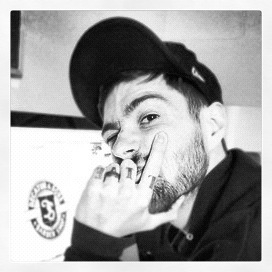How designers work: Richard Stewart on early influences and staying creative
Richie Stewart answers our questions and reveals his top tips for budding designers...

Richard Stewart is a designer and illustrator from Boston. His work includes numerous brands and identities for companies in and around the state of Massachusetts.
Here he talks about how his parents inspired him from a young age and how he favours a more traditional approach to design...
QUESTION: Hi Richie. How did you first get into design?
My mom is an artist/calligrapher who worked from home when I was growing up. I'm an only child, so we spent a pretty serious amount of time together. I will always remember going through her sketchbooks and tracing all the letters and drawings she had made, never being able to do them an ounce of justice.
Later on, getting into punk and skateboarding in my early teen tears allowed me to understand that this whole other world existed, which was a massive eye opener for me. Like there are other weirdo kids that like the same stuff I do.
All the album art, stickers, flyers, decks, stencils...all that stuff just resonated with me on such a deep level and I knew I wanted to be a part of that community, in some way. This led me to understand a pretty young age that I would never be happy working a 'normal' job so I had to figure out a way to get money by making things for people.
QUESTION: What inspires you?
My parents. They taught me to think for myself, do the right thing and pursue what made me happy. I feel like a lot of kids growing up might receive discouragement from their parents because what they were passionate about was not 'practical' in the long run. They backed me every step of the way, in literally every choice I made growing up. I will always be eternally grateful for that.
They also made me work really shitty minimum wage jobs from about age 13 and up. I hated them at the time, but looking back, not only did it build character but it gave me a very intense work ethic. That kinda stuff can't be learned from a book and I am a better person today because of it.
Daily design news, reviews, how-tos and more, as picked by the editors.
QUESTION: What influences your particular approach to design and illustration?
I rarely use anything more than a pencil and the pen tool in illustrator to create the majority of my work. I do my best to embrace that same tactile, hands-on approach to my design and illustration work as the people who paved the way for us today.
Your audience needs to be aware that a human being created the work and not some crazy super computer. There is such a beauty that comes from the imperfection of the the 'hand-made' and I believe that should be embraced.
QUESTION: How do you stay creative?
I try not to overwork myself when deadlines or timeframes allow for that convenience. Engaging in activities that are not design related lets your brain get a bit of a recharge, which is so crucial. I've learned that stepping away from the monitor and doing literally anything else can help me be more creative.
At the risk of sounding stupidly romantic I try my best not to force inspiration, but let it come in a more organic way. You could be watching re-runs of Teenage Mutant Ninja Turtles on TV when your subconscious makes a connection, for whatever reason, and you come out with the best idea you've ever had.

QUESTION: What are your biggest challenges?
Getting myself to sit down and do the actual work. Sounds awful, I know, but finding motivation and inspiration can be a massive uphill battle for me, which totally sounds like a ridiculous cop out! But once I get in the zone, I kind of go into auto pilot. Nothing else really matters until the project is finished. When that creativity strikes I try my best to capitalize on it and work myself to the bone.
QUESTION: And finally. What are your three top tips?

1. Do personal or self initiated projects for no other reason than to make something that didn't already exist. You will, no doubt, create some of your best work this way.
2. Go with your gut. This is not to say you shouldn't be making intelligent, informed decisions based on research for the project at hand. But concepts can sometimes be killed when you overanalyze them.
3. Be nice, stay humble and drop any sort of elitist attitude you may have picked up from your peers at art school or wherever. You aren't as important as you think you are. Be thankful that you get to create for a living...not many people get to do that.
To see more of Richie's work and to contact him, visit his website Commoner Inc

The Creative Bloq team is made up of a group of art and design enthusiasts, and has changed and evolved since Creative Bloq began back in 2012. The current website team consists of eight full-time members of staff: Editor Georgia Coggan, Deputy Editor Rosie Hilder, Ecommerce Editor Beren Neale, Senior News Editor Daniel Piper, Editor, Digital Art and 3D Ian Dean, Tech Reviews Editor Erlingur Einarsson, Ecommerce Writer Beth Nicholls and Staff Writer Natalie Fear, as well as a roster of freelancers from around the world. The ImagineFX magazine team also pitch in, ensuring that content from leading digital art publication ImagineFX is represented on Creative Bloq.
